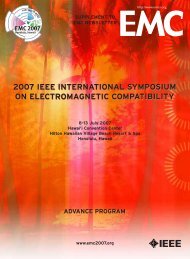reciprocity and emc measurements - IEEE Electromagnetic ...
reciprocity and emc measurements - IEEE Electromagnetic ...
reciprocity and emc measurements - IEEE Electromagnetic ...
Create successful ePaper yourself
Turn your PDF publications into a flip-book with our unique Google optimized e-Paper software.
7e) Equation (23) can also be written astI ( l)iUi= ∫ E ⋅ d lIL10(25)so that I t (l)/I 0 can be considered to be the normalizedcurrent distribution in the transmitting state that weighsthe contributions of incident field in the receiving state.6. Applications (2)This section presents a number of simple applications ofEq.(23) or Eq.(25), dealing with the antenna factor,radiated immunity <strong>measurements</strong> <strong>and</strong> shielding.Interesting <strong>and</strong> rigorously treated applications ofEq.(24) can be found in [15, 25]. Only in simple casescan the integral in Eq.(23) or Eq.(25) be solvedanalytically; an example is given in Section 6.1.However, the other examples will show that quite usefulinformation is made available without solving theintegral.6.1. The λ/2-dipoleA very simple application of Eq.(25) follows if wecalculate the voltage induced in a λ/2-dipole in freespace. As can be found in all current text books onantennas <strong>and</strong> was verified experimentally by Wilmottein 1927 [26], the current distribution in the transmittingstate of this antenna is half a sine wave. If the incidentfield is a plane wave of strength E i with its polarizationparallel to the wire elements, the well known expressionfor the induced voltage follows from Eq.(25):UiE=Ii λ / 4∫I0 −λ/ 402πλ λsin( ( − l))dl= Eλ 4 π(26)If Z m is the effective load impedance <strong>and</strong> Z a the internalimpedance of the λ/2-dipole antenna, the voltage U mmeasured by the receiver is given byZmλ iU(27)m=Z + Z π Em<strong>and</strong> if E i = E c i is the field strength during calibration ofthis antenna, its antenna factor F A is given byFA(28)By stating ‘Z m is the effective load impedance of theantenna’ <strong>and</strong> not ‘Z m is the input impedance of thereceiver’, the properties of the antenna balun areassumed to be taken into account.Seibersdorf, for example, is a supplier of a set of 27λ/2-dipole antennas suitable for performing thevalidation of an antenna calibration test site as describedby CISPR/A [27]. For these antennas Z m = 100 Ω, <strong>and</strong>the free space value of Z a = 73 Ω. Inserting these valuesin Eq.(28) results in F A values that differ less than 0.1dB from the theoretical values supplied by Seibersdorf(maybe, Seibersdorf also used Eq.(28)).aπ( Zm+ Z=λZma)i6.2. The antenna factor F AThis section should clarify which parameters play a rolein the determination of the antenna factor <strong>and</strong> what theconsequences are in radiated emission <strong>measurements</strong>,measurement uncertainty <strong>and</strong> normalized siteattenuation <strong>measurements</strong>.By definition, the measured field strength E m =F A U m , so the antenna factor can be written as(29)The antenna factor therefore depends on 3 variablesdetermined by the calibration set-up, in Eq.(29)indicated by the subscript c,1) The antenna impedance Z a,c ,2) The normalized current distribution I c t (l)/I 0 , <strong>and</strong>3) The outcome of the dot-product E c i ⋅dl along thewire elements.As a consequence, if in a radiated emission measurementone or more of these three variables differ fromthe values during calibration, the antenna factor isunknown. In discussions about the st<strong>and</strong>ardization ofradiated emission tests, the first variable (the antennaimpedance) has often been considered, but not the othertwo variables.The normalized current distribution depends on theinteraction of the antenna with its environment duringits actual use (calibration or radiated emission test). Ofcourse, the outcome of the integral depends on theincident-field distribution which, however, is notspecified in a radiated emission compliance test. Thewire elements of a receiving antenna automatically‘integrate’ over the field distribution whether themeasurement is carried out on an open area test site, orin a semi or a fully anechoic room. Consequently,antennas with different shapes will have differentinduced voltages, even if the incident field is a planewave.∆FA (dB)2,52,01,51,00,5Fig 7.FAZ=m+ ZZma,c∫Lti( I ( l) / I )E ⋅dlThe difference ∆F A = F A (ANSI/3m)−F A (Free-Space) between the antenna factors of a logbiconicalantenna derived from the twocalibration reportsThe combined effect of all three variables comes to thefore in the first example. Figure 7 shows the difference∆F A between the ANSI(3m) antenna factor <strong>and</strong> the free-c0,00 50 100 150 200 250 300Frequency (MHz)10c
















